Medical Disclaimer: This article is for informational purposes only and does not replace professional veterinary advice. Always consult your veterinarian regarding your dog dental care.
Table of Contents
A Healthy Smile Starts with You
If your dog has stinky breath or avoids their kibble, it might not just be fussiness—it could be dental disease. As a small-animal veterinarian in Ottawa, I’ve seen too many loving pet owners overlook early signs of tooth pain, only to end up facing infections, extractions, or worse. The truth is, dog dental care isn’t optional—it’s essential to your dog’s health, comfort, and even lifespan.
Dental disease affects more than just your dog’s mouth. Left untreated, bacteria can travel into the bloodstream, damaging the heart, liver, and kidneys. In fact, over 80% of dogs over the age of three already show signs of gum disease—most without any obvious symptoms. That’s why prevention is everything.
This guide brings together 25 trusted, vet-approved strategies to protect your dog’s teeth at home and with your veterinarian’s help. From daily brushing routines to diet tweaks, chew toy tips, and professional cleanings, you’ll get a complete plan to keep your dog’s mouth healthy. Whether you’re caring for a playful puppy or a grey-muzzled senior, it’s never too late to improve your dog dental care routine—and your dog’s quality of life.
Key Takeaways
- Dog dental care is essential for preventing pain, tooth loss, and serious infections that can impact your dog’s heart, liver, and kidneys.
- Daily brushing with a pet-safe toothpaste is the gold standard of prevention.
- Professional cleanings under anesthesia are necessary to remove tartar below the gumline—something no chew or wipe can do.
- Look for VOHC-approved chews and diets to support daily cleaning efforts.
- Certain breeds and older dogs are more prone to dental issues and need extra care.
A consistent routine that includes brushing, diet, safe toys, and regular vet visits can prevent most dental diseases before they start.
Why Dog Dental Health Matters
Oral Health and Your Dog’s Longevity
Many dog owners are surprised to learn that poor dental hygiene can shorten a dog’s life. Bacteria from untreated gum infections often spread through the bloodstream, affecting major organs like the heart, liver, and kidneys. In my practice, I’ve treated dogs with chronic illnesses that likely started with neglected teeth. That’s why dog dental care is about more than just fresh breath—it’s a life-extending necessity.
What Happens Without Preventative Dental Care
Without regular dog dental care, plaque hardens into tartar, gums recede, and teeth loosen or fall out. Worse, dogs can suffer in silence—many owners don’t realize there’s a problem until their pet stops eating or develops facial swelling. Periodontal disease is common but preventable with simple daily habits and regular vet visits.
Recognizing Dental Problems in Dogs
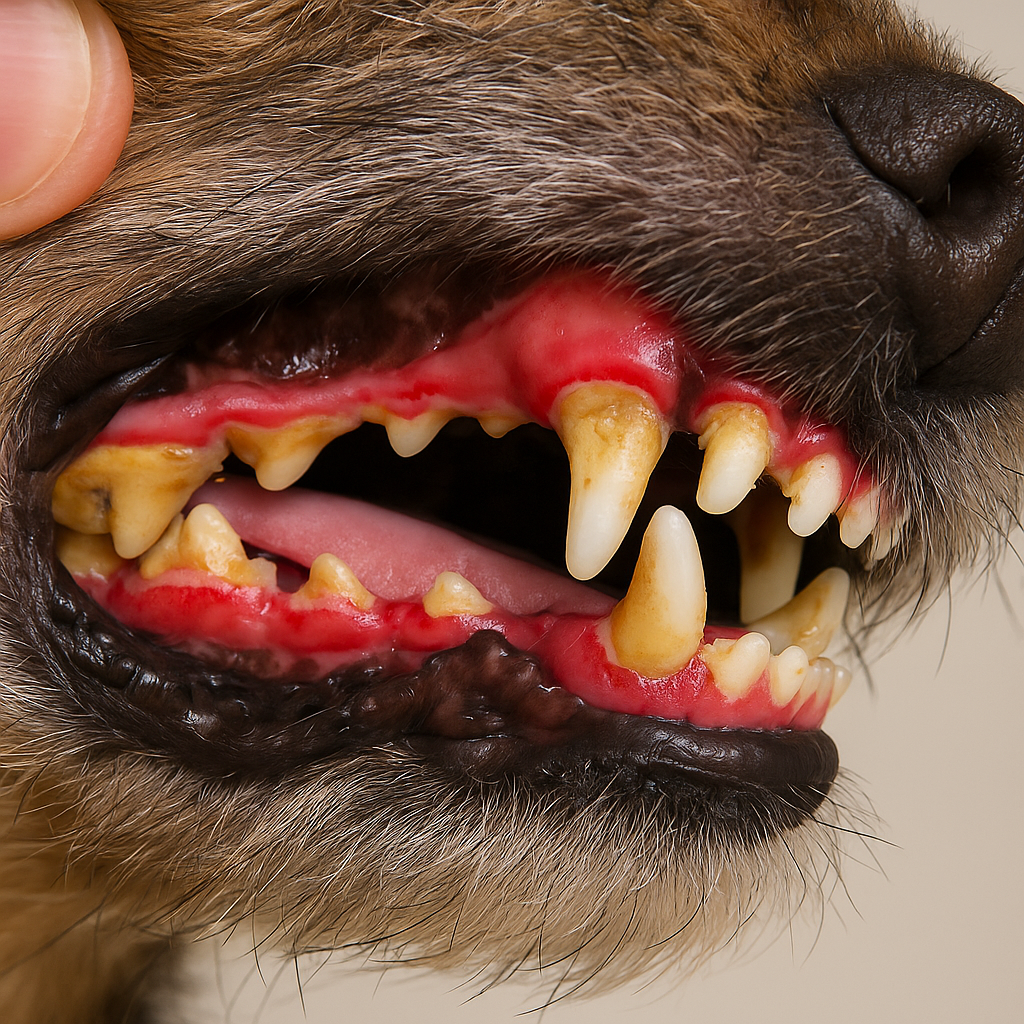
Also visit: https://doglifeexpert.com/7-powerful-ways-to-treat-dog-allergies/
Common Issues: Plaque, Tartar, and Gum Disease
Most dental problems begin with plaque—a sticky film of bacteria that forms on your dog’s teeth. Within days, it can harden into tartar, leading to gingivitis and eventually periodontal disease. These conditions are painful and progressive, and they’re the most common reasons I recommend professional cleanings. Good dog dental care starts with recognizing the signs early.
Early Warning Signs Every Owner Should Watch
You know your dog best. Watch for subtle changes that may indicate oral discomfort, including:
- Bad breath
- Red or bleeding gums
- Dropping food while eating
- Pawing at the mouth
- One-sided chewing
- Facial swelling
If you notice any of these symptoms, don’t wait—book a dental exam. Most dental disease hides below the gumline and gets worse over time.
Table: Common Dog Dental Issues & Symptoms
| Dental Problem | Signs to Watch For |
|---|---|
| Plaque & Tartar | Bad breath, yellow/brown deposits, gum redness |
| Periodontal Disease | Bleeding gums, loose teeth, pain, gum recession |
| Tooth Root Abscess | Facial swelling, pus, reluctance to eat |
| Tooth Fractures | Pain chewing, broken tooth, dropping toys |
| Tooth Decay (Caries) | Discoloured teeth, bad odor, eating difficulty |
Daily At-Home Dental Care
How to Brush Your Dog’s Teeth (Vet Method)
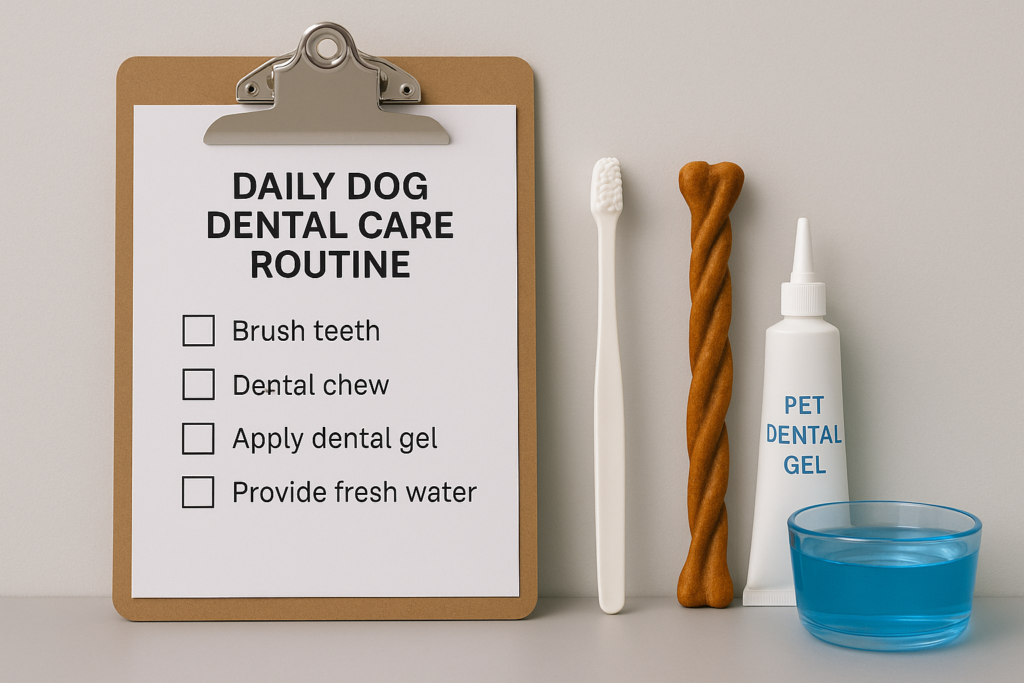
The cornerstone of effective dog dental care is daily brushing. I recommend starting this habit early—even puppies can get used to it with gentle handling and rewards. Use a soft-bristled pet toothbrush and an enzymatic toothpaste made just for dogs (never human toothpaste). Focus on the outer surfaces and brush in small circles at a 45-degree angle to the gumline.
If your dog resists at first, ease into it:
- Start by rubbing your dog’s gums with a damp cloth or finger.
- Introduce toothpaste by letting them lick it.
- Progress to short brushing sessions, gradually increasing time.
Dental Chews & Safe Toys
When brushing isn’t possible every day, VOHC-approved dental chews are a great addition. I often recommend:
- Greenies™ Dental Chews
- Virbac C.E.T.® VeggieDent® Fr3sh™
- Purina DentaLife™
- Milk-Bone® Brushing Chews®
These are designed to scrape away plaque and reduce tartar with regular use. Chew toys made of rubber or nylon (like Kong toys) are also helpful, especially those with ridges or textures.
Avoid: Antlers, bones, hard plastics, and tennis balls. I’ve treated many fractured teeth from these.
Other Helpful Products (Wipes, Water Additives, Gels)
Not all dogs tolerate brushing. In these cases, you can add:
- Dental wipes
- Chlorhexidine-based gels or sprays
- Water additives (VOHC-approved)
These can reduce bacteria and freshen breath but are best used alongside brushing—not as a replacement.
Checklist: 5-Minute Daily Dental Routine
- Brush with pet-safe toothpaste
- Offer a VOHC-approved chew
- Add dental water additive
- Inspect gums and teeth for changes
- Praise and reward your pup
Dog Dental Diets & Smart Treats
Choosing Dry Kibble Over Soft Food
When it comes to dog dental care, what your dog eats matters. Dry kibble is generally better than canned food because it helps scrape away plaque during chewing. Soft food tends to stick to the teeth and accelerate tartar buildup. If your dog has medical issues requiring wet food, talk to your vet about balancing oral hygiene with their dietary needs.
VOHC-Approved Dental Diets
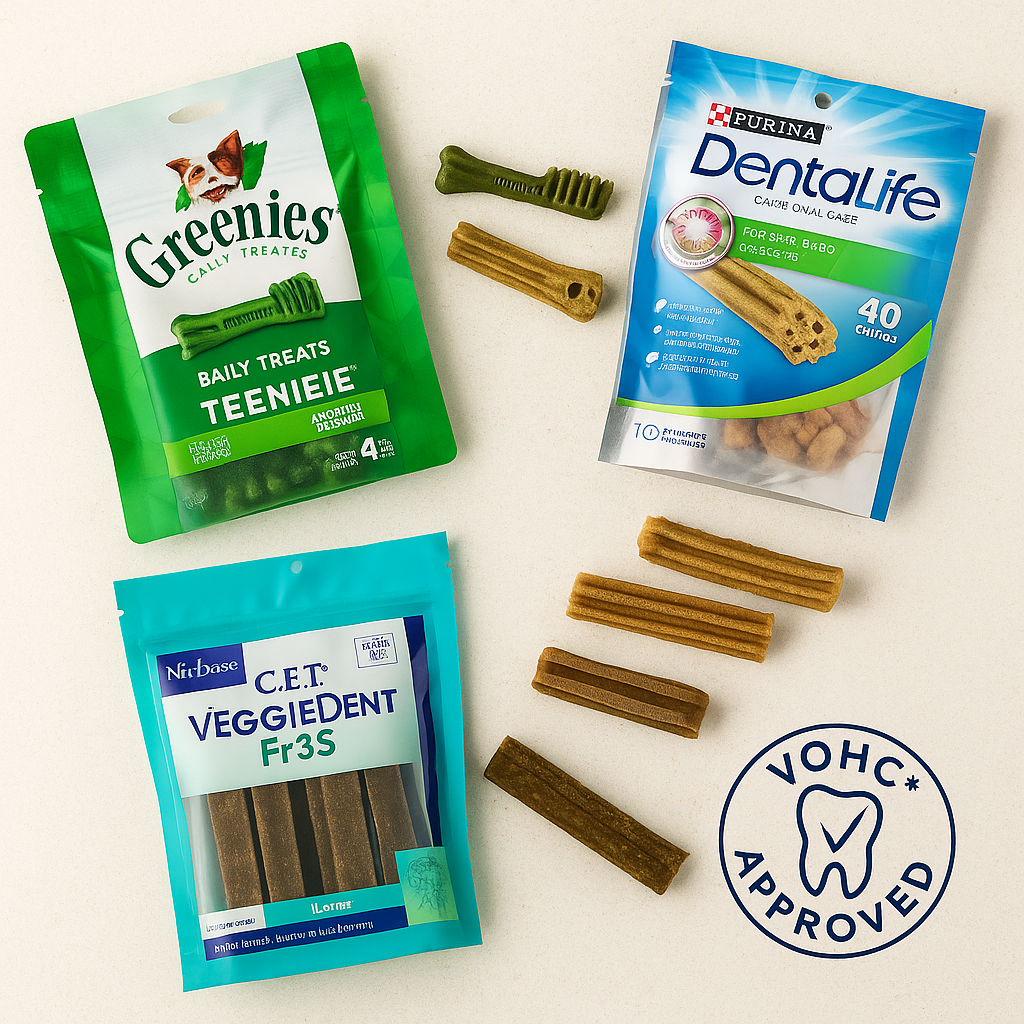
Special veterinary dental diets can make a big difference. These kibble formulas are engineered to clean teeth as your dog chews. One of the most trusted options is:
It has the VOHC Seal of Acceptance for tartar control and supports full-body health with added antioxidants and protein.
Fruits, Veggies, & Supplements That Help
Some whole foods support good dog dental care when used as low-calorie treats:
- Carrots & apples: Crunchy texture helps clean teeth.
- Pumpkin: Rich in fiber and gentle on digestion.
- Plain yogurt/kefir: Provide probiotics that may reduce oral bacteria.
- Fresh water: Keeps the mouth flushed and supports healthy saliva.
Use these in moderation—treats should make up no more than 10% of your dog’s daily calories.
Professional Veterinary Dental Cleanings
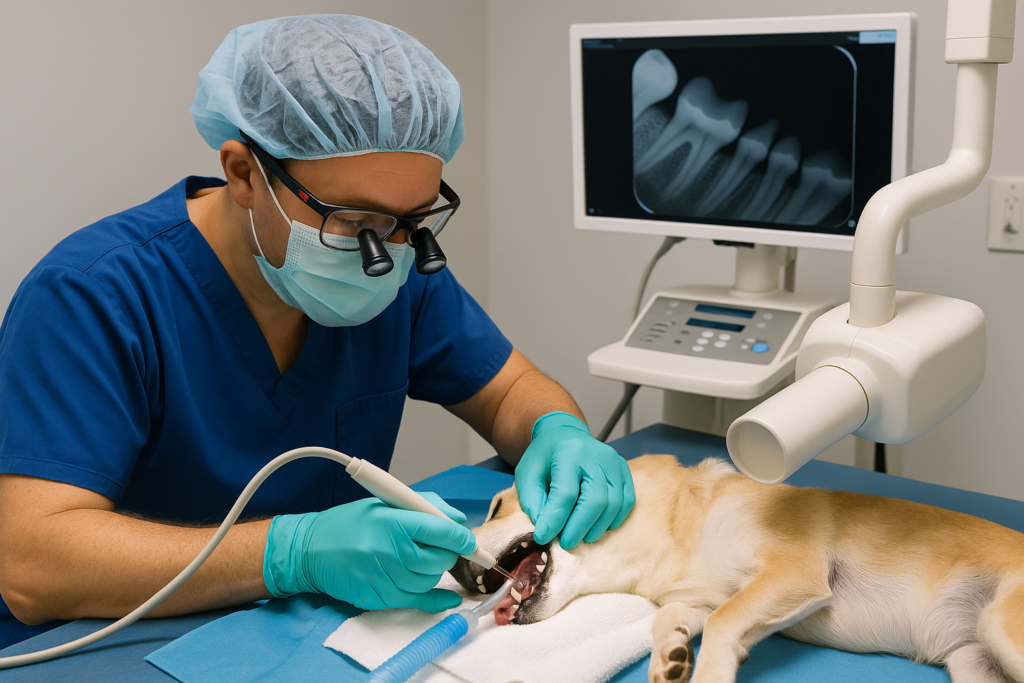
Why Anesthesia Is Necessary
No matter how thorough your at-home routine is, professional cleanings under anesthesia are still essential for complete dog dental care. That’s because most dental disease happens below the gumline—where toothbrushes and chews can’t reach. Anesthesia ensures your dog stays still and pain-free during deep cleaning, X-rays, and any needed extractions.
In my practice, I’ve seen anesthesia allow us to discover hidden infections, root abscesses, and bone loss we never would have found without it. With modern monitoring and individualized protocols, anesthesia is very safe—even for seniors.
What Happens During a Dog Dental Cleaning
A professional dental cleaning is a crucial part of responsible dog dental care, especially because most disease occurs below the gumline—where brushes and chews can’t reach. Here’s what your dog will experience during the procedure:
- Pre-anesthetic bloodwork – Ensures your dog’s organs can safely handle anesthesia.
- Anesthesia and airway protection – Keeps your dog calm, pain-free, and prevents aspiration.
- Full-mouth dental X-rays – Helps detect hidden issues like abscesses or bone loss.
- Charting of teeth and gum condition – Each tooth is examined, noting disease or damage.
- Scaling (above and below the gumline) – Removes tartar and plaque to stop gum disease.
- Polishing – Smooths the tooth surface, preventing new plaque from sticking.
- Irrigation and fluoride – Cleans and protects the teeth with antibacterial and enamel-supporting solutions.
- Extractions (if needed) – Severely diseased teeth are removed with pain management.
- Recovery and pain control – Your dog is monitored closely and given aftercare instructions.
Veterinary cleanings are not cosmetic—they’re medical procedures essential to long-term dog dental care. Combined with regular brushing and check-ups, they form the backbone of a strong dog dental care plan that protects your pet’s comfort and overall health.
Every step supports long-term dog dental care, making this more than a cosmetic procedure—it’s preventive medicine.
Typical Canadian Cost for Dog Dental Cleaning
| Service Type | Estimated Cost (CAD) |
|---|---|
| Routine dental cleaning (no extractions) | $600 – $1,000 |
| With multiple extractions | $1,200 – $2,500+ |
| Pre-anesthetic bloodwork | $100 – $200 |
| Full-mouth dental X-rays | $200 – $400 |
Prices vary by region, clinic, and the complexity of care.
How Often Should Dogs Get Cleanings?
Most dogs benefit from a professional cleaning every 12–24 months, depending on age, breed, and at-home care. Dogs with known dental issues or high-risk breeds may need cleanings more frequently.
Special Dental Considerations
Breeds Prone to Dental Issues
Some breeds need extra help with dog dental care due to genetics or skull shape. I always caution owners of these dogs to be more proactive with brushing and professional cleanings:
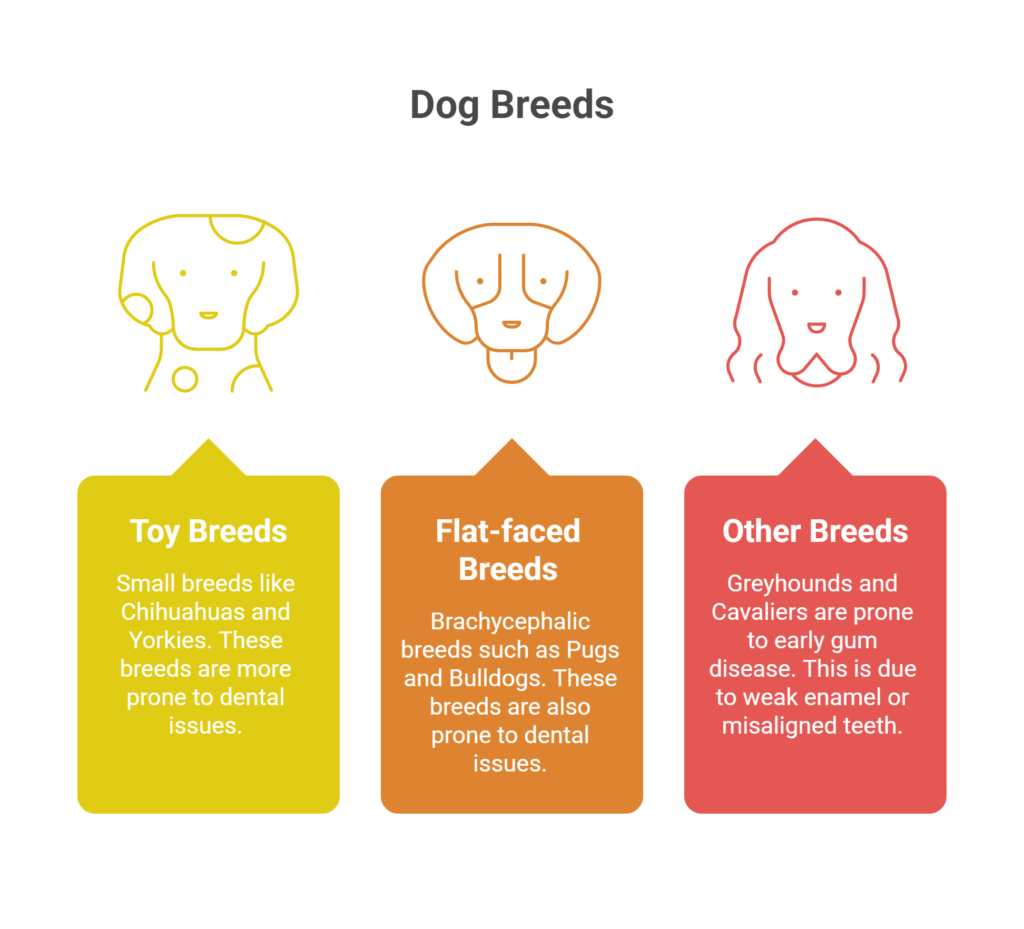
These dogs often have crowded mouths or shallow roots, which make plaque and food harder to remove naturally.
Age, Genetics & Lifestyle Factors
- Older dogs: Over 3 years old? Then your dog has a high chance of developing early periodontal disease.
- Genetics: Some dogs are born with poor tooth alignment or weak enamel.
- Diet and chewing habits: Dogs eating wet food or not chewing enough have faster tartar buildup.
- Neglected care: Without daily routines and cleanings, most dogs will eventually need tooth extractions.
Knowing these factors allows you to tailor a dog dental care plan that keeps your dog smiling for life.
25 Vet-Approved Dog Dental Tips
Use this list as your go-to checklist for maintaining great dog dental care at home and in partnership with your vet.
- Schedule annual veterinary dental exams
- Start brushing when your dog is a puppy
- Brush your dog’s teeth daily, or at least 3–4× per week
- Use a soft, pet-specific toothbrush
- Use enzymatic dog toothpaste (never human toothpaste)
- Focus brushing on the outer (cheek) sides of the teeth
- Use gentle circular brushing motions
- Make brushing fun with treats and praise
- Pick chews with the VOHC Seal of Acceptance
- Offer VOHC-approved products like Greenies or DentaLife
- Avoid hard chews: no antlers, cooked bones, or hard plastic
- Supervise chewing sessions
- Avoid abrasive toys like tennis balls
- Choose dental-safe rubber or nylon toys with ridges
- Offer fruits like carrots and apples for light chewing
- Consider dental diets with proven efficacy (like Purina DH)
- Prioritize dry food over wet food if possible
- Avoid sugary snacks or high-carb treats
- Keep fresh water available at all times
- Add VOHC-approved dental water additives if brushing isn’t daily
- Use dental wipes or sprays as brushing alternatives
- Watch for signs of pain: drooling, chewing on one side, bad breath
- Be especially diligent with high-risk breeds
- Don’t skip professional dental cleanings under anesthesia
- Ask your vet about your dog’s specific dental risk factors
Following these steps regularly is the most reliable way to stay ahead of dental disease.
FAQs About Dog Dental Care
How can I tell if my dog’s teeth hurt?
Dogs often hide pain well, but signs of dental discomfort include bad breath, dropping food, pawing at the mouth, or avoiding hard toys. Subtle behavior changes, like irritability or eating slower, also point to a possible problem. Regular dog dental care can help prevent this pain from ever starting.
Is anesthesia safe for older dogs?
Yes, when properly assessed. I’ve safely anesthetized many senior pets using tailored protocols and pre-anesthetic bloodwork. The benefits of a thorough cleaning usually outweigh the minimal risks—especially if infection or pain is present.
What if my dog won’t let me brush?
Start slow with your fingers or a cloth. Use flavored toothpaste as a treat first, then build up to brushing. If your dog truly resists, use dental wipes, chews, or VOHC-approved water additives while you keep trying. A consistent dog dental care routine often becomes easier with time.
Are dental chews enough on their own?
No. Chews are helpful but can’t remove plaque below the gumline. They work best when paired with brushing and regular vet cleanings. Think of them as floss—not a substitute for brushing.
How often do dogs need cleanings?
Most dogs benefit from a professional dental cleaning every 12–24 months, depending on age, breed, and at-home care. High-risk breeds or dogs with a history of dental issues may need them more frequently. Ask your vet for a personalized dog dental care timeline.
Conclusion: A Smile That Lasts a Lifetime
Dental disease is one of the most common and preventable health issues in dogs. As a veterinarian, I’ve seen firsthand how proper dog dental care can transform a dog’s life—from easing chronic pain to improving energy and mood. It’s not just about clean teeth—it’s about comfort, longevity, and quality of life.
By combining daily brushing, safe chews, smart diet choices, and regular professional cleanings, you create a complete defense against dental disease. Whether you’re caring for a spry puppy or a senior dog, it’s never too late to start.
With the tools in this guide and a little consistency, dog dental care becomes a habit—and a gift that keeps your dog happy and healthy for years to come.

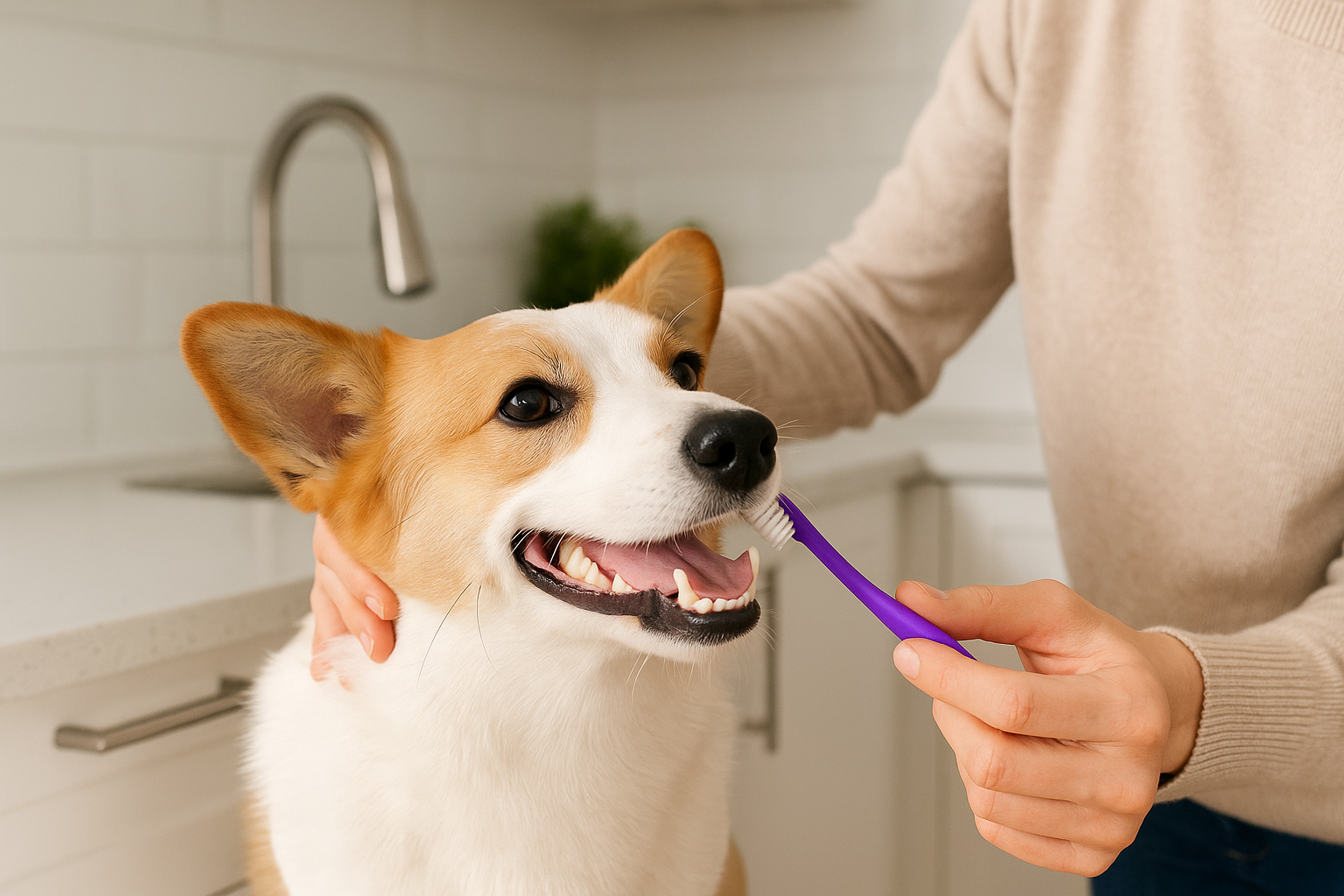
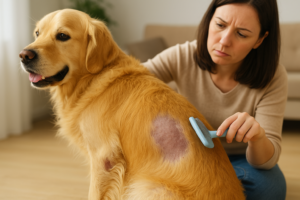
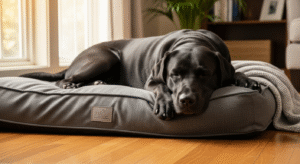

Pingback: Top 5 Alarming Dog Skin Conditions: Vet-Approved Fixes That Work